
|
Feedback Form

| DATA Guidance Notes - Key Stage 2 [ 4.1 ] |
Written by Mary Westhead and Peter Lovat on behalf of DATA
Design and Make at Key Stage 2
Introduction
Under the guidance of their Adviser, Richard Green, a group of Bromley teachers developed a term's work using the Inventa design and make system from Valiant Technology This guidance note follows the development of two of these projects and looks at how Inventa contributed to the successful outcomes.
Wickham Common Primary School
Water Lifting Machines
Key Stage 2 (Year 3) Time Allocation 1 Term
Context
Designing and making a machine that will lift water
Potential Outcomes
A variety of model machines that use a mechanism to lift a container of water 20 cm
Materials Focus
Construction materials for frameworks, lever, winch and pulley mechanisms
Curricular Links
History - water lifting machines used in ancient times, Shaduf, Archimedes Screw, water wheels, wells etc. Science - forces and motion
Resources
Books, posters, pictures and videos showing lifting machines and wells. Wood strip, dowel, sheet materials, link strip, plastic dowel, Inventa components. Junior hacksaws, bench hooks, clamps, PVA glue, glue guns. String, reclaimed materials, pots and boxes
Programme of study/Learning objectives focus
3 Designing skills
a use information sources to help in their designing
b generate ideas, considering the users and purposes for which they are designing
d consider appearance, function, safety, and reliability when developing proposals
e explore, develop and communicate aspects of their design proposals by modelling their ideas in a variety of ways
4 Making skills
a select appropriate materials, tools and techniques
b measure, mark out, cut and shape a range of materials using additional tools, equipment and techniques
c join and combine materials and components accurately in temporary and permanent ways
5 Knowledge and Understanding
Control
c how simple mechanisms can be used to produce different types of movement
Health and safety
j recognising hazards to themselves and to others in a range of products, activities and environments
Vocabulary
k to use the appropriate vocabulary for naming and describing the equipment, materials and components and processes they use
Management & organisation of learning
Investigative, disassembly & evaluative activities (IDEAs)
< Provide a collection of pictures, photographs and video of water lifting machines
< Ask the children to observe how the different mechanisms in the machines work
Focused practical tasks (FPTs)
< Make a class/group working model of a shaduf
< Safe use of the junior hacksaw and a glue gun
< methods of joining link strip or timber strip to make a framework
< how to make simple lever, pulley and winch mechanisms
There should be opportunities for children to explore mechanisms and making them work with construction kit or Inventa
Design and make assignments
< Explain to the children they are going to design and make model water lifting machines
< Recap on IDEAs and FPTs about mechanisms and how they work and to choose the most appropriate one for their design
< Work out initial ideas through drawing and modelling
Children should have a clear idea of what they are making and how they are going to make it before starting
< considering which materials they are going to use
< remind children that the water must be lifted 20cm
< try and test out the mechanism they want to include in their design
Extension activities
< Design an alternative power source to muscles for their water lifting machine
Assessment opportunities
L2 Designing: children can
explain how they might use ideas gained from looking at water lifting machines
produce pictures of their idea for a water lifting machine
Making: children can
select from a range of tools, techniques and materials
use tools safely to join materials for their machine
L3 Designing: children can
produce labelled sketches for their machine designs
use their knowledge of mechanisms to help with their ideas
Making: children can
Make a machine similar to original design, explaining any changes
L4 Designing: children can
gather own information to help generate ideas adapt ideas and mechanisms and incorporate into their own design
use sketches and models to help choose from alternative designs
Making: children can
produce step by step plans and indicate materials and mechanisms to be used
evaluate their machine and identify what is, and what is not working well
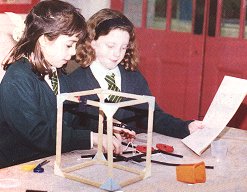 The
Design and Make Assignment
The
Design and Make Assignment
The Year 3 assignment was to make a model machine that could lift a container of water at least 20cms. The work was to focus on framework construction and lever, pulley and winch mechanisms.The work was to be part of a topic about Ancient Egypt, as part of their history work. The children learnt about the River Nile and its importance to the ancient Egyptians. The children also saw photographs, carvings and video footage of modern and ancient shadufs lifting water from the Nile.
Investigative, Disassembly & Evaluative Activities and Focused Practical Tasks.
The class researched a variety of ancient water lifting mechanisms including the Archimedes Screw, water wheels and well mechanisms. We also made a working shaduf that could lift a full sized bucket of water. This lead to some investigation of levers and how they work.
There was also some class work about winch and pulley mechanisms and how they are used in lifting machines such as cranes. The Inventa Book of Mechanisms proved very useful as a resource about how mechanisms work and where they are found.
The children were then briefed about the assignment and we started to collect yoghurt pots and other reclaimed materials that might be useful.
This was also the first time I had Inventa components available for a design and make activity, so I showed the children the different parts and how things fitted together. I also showed them the reamer drill and how this would make the holes in the link strip and other components slightly larger for a running fit rather than the normal push fit.
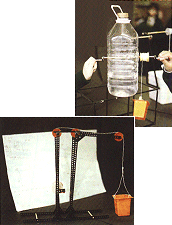 Designing
and Making
Designing
and Making
The children then working in pairs started to design their machines. A variety of different ideas were put forward including machines based on cuboid shapes, "A" frames and traditional crane shapes.
Initially many design ideas used wood strip (the children had made simple wood strip chassis the year before), but as the work started the children quickly picked up from others working around them that it was much quicker to make a framework from the Inventa link strip. Certain shapes like "A" frames were harder to cut accurately in wood strip, but the Inventa link strip could be joined at a variety of angles using pins and flange plates.
Designs which had originally included Inventa pulleys were then also modified in several cases to be constructed using link strip, often in conjunction with a variety of found materials.
Pulleys and winch drums were easy to fit onto standard 5mm dowel and the link strip with its pre-formed holes made it easy for the children to line up pulleys across their machines. As the designing and making progressed ideas were modified if a mechanism or structure did not work well. I found that children who had constructed their framework from link strip were able to quite quickly disassemble their model and modify what was necessary and then reconstruct it using mostly the same parts. This was a much more daunting task for the children whose frameworks were made from wood strip.
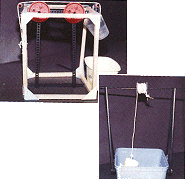 The
other big advantage to using Inventa for these machines was the availability
of a range of different sized pulleys and the ready-made winch drums (rather
than the usual cotton reels that don't really fit well on any shaft).
The children understood the principles of the mechanisms (thanks to the
Inventa Book of Mechanisms) and could therefore work out which mechanisms
were appropriate for their machines. It would have been an impossibly
difficult task if they had then had to make the components too.
The
other big advantage to using Inventa for these machines was the availability
of a range of different sized pulleys and the ready-made winch drums (rather
than the usual cotton reels that don't really fit well on any shaft).
The children understood the principles of the mechanisms (thanks to the
Inventa Book of Mechanisms) and could therefore work out which mechanisms
were appropriate for their machines. It would have been an impossibly
difficult task if they had then had to make the components too.
In the end the class made a variety of different machines that met the design criteria of lifting a pot of water 20cms and the majority of the machines worked as the children intended and looked like their design sketches. Inventa made a huge difference to the children's work, the main advantages I saw were:
- An increased range of designs
- Quicker construction time
- Strength of joints, using plates and pins
- Ability to disassemble and modify a design, then reassemble quickly
- Accurate, inexpensive mechanism components that fit together well
- Successful working models that look like the children's designs
St Anthony's RC Primary School
Bridges
|
I have a mixed ability year 4/5 class and, in addition, I was taking a very lively year 5 class for Technology during the Summer Term. I had already decided on the topic of "bridges", since this gave great scope for looking at different types of structures, not just in theory, but in real life. At the beginning of the project, the children looked in detail at different types of bridges - beam bridges, suspension bridges, swing bridges, arch bridges, to name but a few. They also discovered that some bridges were combinations of different types (just to confuse the issue!). Of course, eventually they were asked to design and make the bridges, which is where the frustration began. Although the children were reasonably skilful with woodworking tools, they found the woodstrip we were using very unsatisfactory, not only because it demanded a level of skill beyond a number of the children, but also because the wood did not do what they wanted, or look as they expected. At that stage I went along to the Inventa workshop (somewhat reluctantly I must admit!), and what I found seemed immediately to answer my bridge-building problems. Firstly, the Inventa components (gears, pulleys, link strip etc.) are designed to interface with the woodstrip and also allowed us to build "proper" strucures. Secondly it had some well thought out design sheets which led the children through the different stages of a design - these were an immediate success back at school. When I took my Inventa Starter Pack into the classroom, I offered it alongside the materials that the children were using already and most children decided to use it. What most impressed them, I think, was that they could use it with the wood, card, and other materials that they were already using - they did not have to use it exclusively (unlike construction kits). The children had no difficulty with the Inventa materials. They were able to mix plastic, wood, card and any other material as they needed. They had a geniune choice of materials and could select according to properties required. The components were easy to use, providing an accuracy that gave good results while still encouraging the development of many skills. The person with the biggest problem was me, the teacher! After years of saying, "Don't lose the little bits" and counting them out and back, it was a major culture shock to realise that Inventa is cheap enough to be disposable (some bits can be reused if you want though). I was very pleased with the results of our bridge-building project this year, and so were the children. Inventa is now a must on our list of resources. |
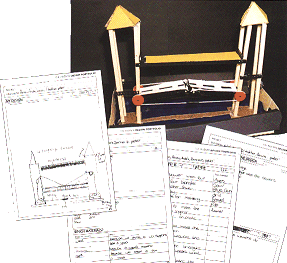 |
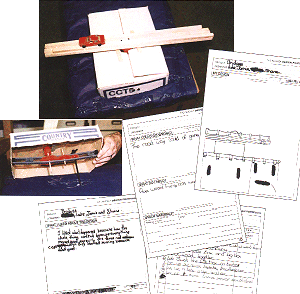 |
Inventa - a complete design and make system
Dave Catlin, managing director of Valiant and designer of Inventa answers questions about this technology product from Valiant.
 What
made you think that there was a need for a design and make system when
there are component parts already available?
What
made you think that there was a need for a design and make system when
there are component parts already available?
We like to listen to teachers to find out what they feel they need and it became very obvious over a period of time with lots of teachers complaining of the difficulty they found in implementing the design and make part of the technology curriculum. In addition OFSTED reports pinpointed specific needs, such as the lack of suitable resources and the need for training for non-specialist teachers. Research showed that there was no complete system and the component parts available didn't integrate together so success depended less upon the child's ability that the quality of the mechanisms.
So what does Inventa consist of?
Inventa is a complete system. It consists of mechanisms, structural components, raw materials, textbooks, teacher's notes, activity sheets, tools, design sheets and a training video. All of extremely high quality.
What makes Inventa different?
Our research highlighted five areas of concern for teachers and so in the development of the system we have addressed these problems:
Practical materials - The system is based on the familiar woodstrip system and is designed to integrate with existing practice and resources. Pupils use their normal found materials and then use whatever Inventa components they need to ensure accuracy and precision. All the component parts fit together and actually work, reducing the frustration often associated with design and make and increasing motivation.
Curriculum links - The support material helps show how design and make can be incorporated into topic work and normal classroom activities. The documentation provides an accessible route into technology within a range of contexts and subject areas.
Professional development - The documentation and video focus on the development of teacher's technological skills and knowledge as well as providing information on all aspects of technology from writing a school policy through to classroom organisation.
Classroom support - The activity cards are fully illustrated with solutions without being prescriptive. Design sheets guide pupils through the design and make process and the video shows how to progress safely. Most importantly, the text books make technology accessible and understandable.
Cost - This was obviously a very important factor for the teachers. We have worked hard to keep the cost at a level where the materials can be considered consumable thus allowing the work to be displayed or taken home.
 By
solving the problems for teachers we have designed a system that is totally
integrated yet fully tlexible. Although it's based on the woodstrip system
the addition of structural elements give real design choice by opening
it up to using a wide range of everyday materials in an effective technical
manner.
By
solving the problems for teachers we have designed a system that is totally
integrated yet fully tlexible. Although it's based on the woodstrip system
the addition of structural elements give real design choice by opening
it up to using a wide range of everyday materials in an effective technical
manner.
It has also been designed to work.
Do you intend to produce any more parts to the system?
Yes. We are developing topic packs that will contain workcards and materials to take pupils though skill and knowledge development. They start in a very structured way ending up with open-ended design briefs. For instance we are devloping a pack on designing a wind garden. The pupils will start off making very simple windmills driven by air and work through to developing their own more sophisticated mechanisms, for example a bubble blowing machine. This project combines all that is great about technology - an understanding of mechanisms and structures, a development of skills and an appreciation of the aesthetic qualities of good design.
We have also developed Tronix which provides an electrical element to any Inventa models. Tronix packs contain components and documentation of the same high standard that is now expected from Valiant Technology.
| Back |
|---|